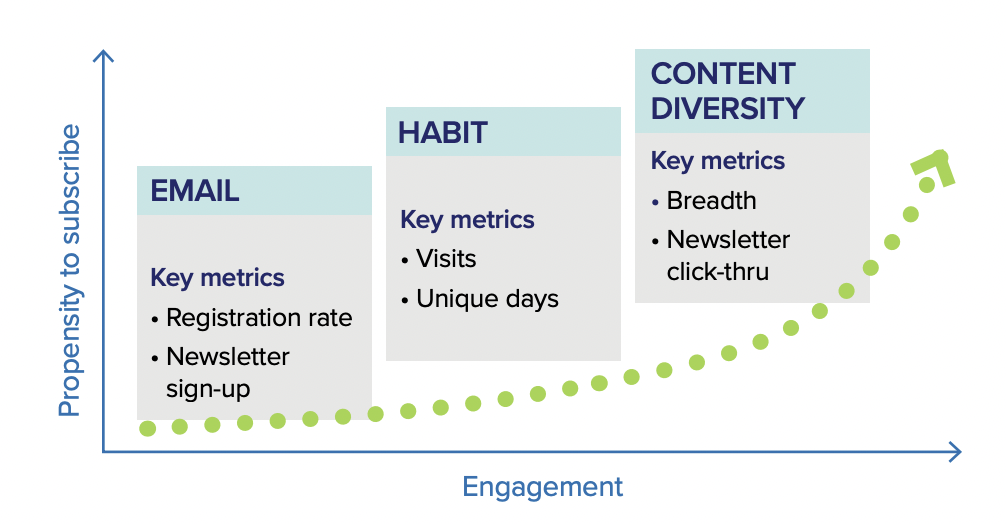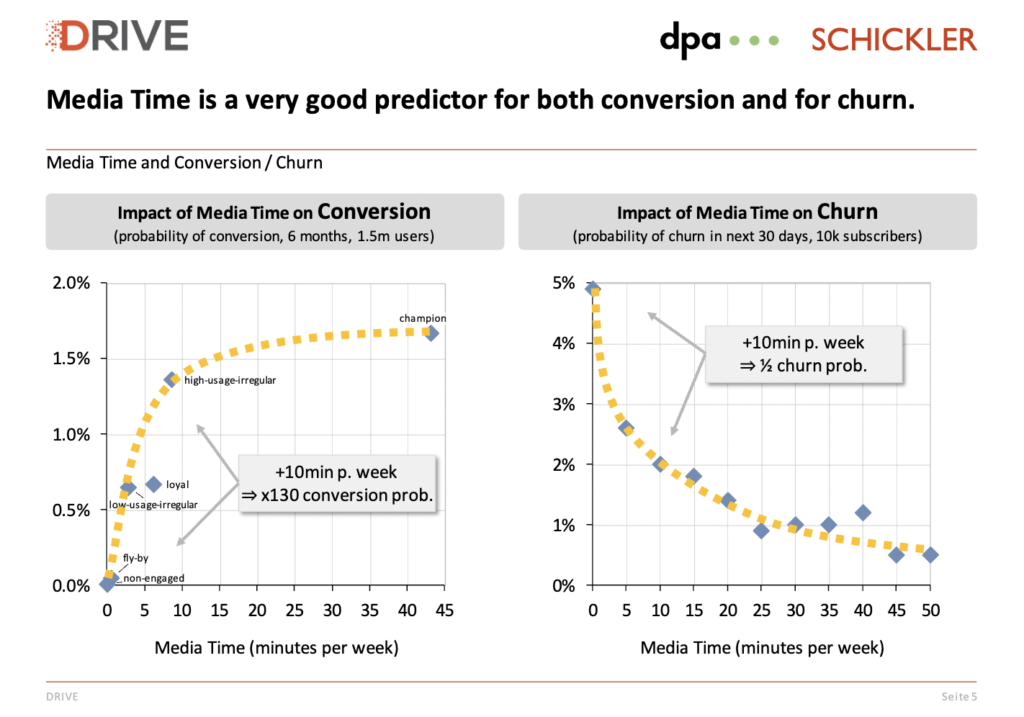

A few readers have brought up this question – whilst there’s no shortage of engagement data available, many are struggling to prioritize metrics, understanding which are actually valuable to track with the end goal being to increase reader revenue.
So we’re back with our second “Ask the experts” article. This time we’re sorting through all the potential engagement metrics to uncover those that should be at the top of your reports for not only increasing conversion rates, but also supporting high retention, something that is key to success in subscription models.
TL;DR – Linking engagement to revenue is key, measuring & seeking to increase retention and Customer Lifetime Value. But, instead of simply tracking the engagement metrics that everyone else is following, turn the question around to look at your data first, finding the answers in your most engaged, high-value readers.
Let’s start by evaluating the variety of metrics considered ‘useful’
Google’s Reader Revenue playbook lists 5 core engagement metrics:
- Average visits per user
- Average page-views per user
- Average page speed
- Newsletter opt-in rate
- Percentage of known readers (note that known unique visitors include digital and print subscribers, registered users, and email capture visitors)
Whilst the first 3 relate more to content engagement onsite, the final two measure the value of specific engagement strategies that are considered valuable for increasing propensity to subscribe:
Newsletter sign up:
- If sent at a set time, newsletters form a habit, something that has been widely proven to increase engagement as your content takes a place in your reader’s daily or weekly routine
- Readers can choose which newsletter to sign up to, meaning it’s adapted to their interests
- Bring content to the reader rather than expecting them to come to you
- Build a more direct relationship with your readers
Increasing the % of known readers:
Publishers across the world are starting to see the value in registration for increasing propensity to subscribe and reducing churn:
- The New York Times’ registration model has increased conversion rates to subscription by more than 40%
- Registered users on L’Équipe are 13 times more likely to subscribe than anonymous readers
- At The Independent, de-anonymized users are 45 times more likely to subscribe
More than just page-views, diversity of pages viewed is also important
Mather Economics highlights the importance of moving away from only tracking page views, also considering (and trying to increase) the diversity of pages viewed:
“Many content-recommendation algorithms boost page views by serving readers content on a topic they’ve demonstrated an interest in. Publishers should ensure their engagement and marketing tactics (e.g., a content recommendation engine) do not only focus on pushing visit frequency or visit depth (i.e., number of pages read). Recommendations should also expose readers to a diverse array of topics and authors in order to broaden engagement. In a subscriptions context, “breadth” of experience appears to deepen likely subscribers’ perception of the value proposition.”

Media time – how much time does a user give you?
Publishers in DRIVE, the digital reader revenue initiative, measure the success of their stories with 3 key metrics:
- Media time -> How big is the total reach?
- Number of Champions -> How many users use the news websites and apps intensively?
- Subscription Rate Champions -> How many of these intensive users could be converted into a subscription?
“The most important metric is Media Time – how much time does a user give us on a website or app? Media Time is easy to understand for editors and analysts. And data analyses show that Media Time can predict conversion and churn very well. The conversion probability increases by 130 times if the media time increases by 10 minutes per week. The churn probability is halved if the media time increases by 10 minutes per week.”
Katja Fleischmann, product manager at dpa infocom, and Dr. Ole Martin, data scientist at Schickler consultancy

Be informed by your audience
It was my conversation with Steve Price, digital publishing consultant who has previously held senior roles at Dennis Publishing, Hearst, iSubscribe and the Telegraph, that really dove into the heart of the metrics to track in a reader revenue model.
The key: instead of starting with engagement, turn to look at your most loyal subscribers to discover what engagement actions are linked to highly valuable users.
Think of subscription as a bucket with holes. Users flow through but engagement fills the holes, keeping people in the bucket. Engagement is therefore a tool to persuade someone to convert and stay, rather than the goal in itself.
Ultimately, Steve told me, it’s about linking engagement to the pounds, dollars and euros.
Engagement, for the sake of acquisition, may be ‘quick’ to turn around, but it costs more than retention and is less valuable to your business in the long run.
I.e. Which metrics will help you reach your revenue goals?
Concretely, how do you put this into practice?
“The answers are in front of you”
Analyze who your existing customers are, what do they do, how do they consume your content, when do they engage with you, how often?…
For Steve, this means putting Lifetime Value (LTV) as your north star metric:
Lifetime value = subscriber value x average customer lifespan
The result will give you the revenue that you can reasonably expect an average subscriber to generate for your company throughout their relationship with you.
However, the main value lies in analyzing these high-value subscribers, asking yourself what ‘type’ of engagement correlates with high retention rates. If you can link engagement to retention, then you’ll gain a deeper understanding of how you can increase engagement to secure high conversion and retention rates.
For example, The Lenfest Institute found that the likelihood of readers becoming paid subscribers increases the most when they read 5+ articles per month or provide their email address, amongst other engagement actions.

This creates a typical, high-value ‘persona’ which can then inform your engagement strategy and metrics.
How are publishers already linking engagement to revenue?
For Katja Trost, Teamlead Customer Retention at Die Presse, the most important metric for subscriber growth is churn rate:
“In my opinion, engagement measures the value a subscriber is receiving from my products. So revenue is connected to engagement by looking at KPIs such as churn rate or customer lifetime value. There is no doubt that acquiring a new subscriber is much more expensive than retaining an existing one.”
The key to growth is subscriber retention: spending time, money and energy on growth without fixing retention is like sailing a boat with holes in the bottom! During our off-boarding process we try to win back lost subscribers with an attractive offer and by triggering FOMO. In this context, the return rate is a significant metric. Nonetheless, it is most important to prevent churn in the first place. One approach to achieve this is to identify customers who are likely to churn or show low engagement. In such cases, we attempt to revive the so-called “zombie” users, who have not interacted with us for a considerable period of time, by implementing appropriate strategies.”
Work can then be put into uncovering these “appropriate strategies”, analyzing subscribers with high retention rates and their behavior.
For instance, Luis Baena Reig, Chief Marketing Officer at El Pais, who have now surpassed 250,000 digital subscribers, spoke at INMA’s recent Media Subscriptions Summit about linking engagement actions to retention:
“We know that engagement is key,” Reig said. “This is something that most of us know. Those subscribers that subscribe to newsletters, which in our case is like 60%, have 24% less churn. Those that subscribe to our premium newsletters, only available for subscribers, have 29% less churn. And those that use our loyalty schemes with additional benefits have 30% less churn.”

For Katja Fleischmann, product manager at dpa infocom, and Dr. Ole Marin, data scientist at Schickler consultancy, who work together on the DRIVE unique data initiative, it’s not so much about individual actions (e.g. final click attribution score) but more the engagement along a user’s journey to conversion:
“We incorporate engagement-metrics in the main relevant revenue-metrics. I.e. for conversions we do not focus on the total number of conversions on an article paywall as last-click-attribution. However, we use a Conversion-Attribution-Score that assigns a Conversion-Attribution to all articles read by a user in the previous 28 days before they convert. And this Conversion-Attribution-Score is proportional to the Media-Time (Engagement) spent on the articles. In this way we attribute the conversion to all user engagement on the journey to conversion. In a soccer analogy we do not only look at “goal-scorers” (articles, on which users convert) but also at the “assist-givers” (articles that keep users engaged so that they finally click on a goal-scorer-article. These can also be free articles). As in soccer there are usually way more articles setting up the conversion than articles that convert. And the role of the assist-givers is often underestimated.
In the future, the ultimate goal is to use a reader value model that attributes monetary values (uplifts in CLV) to the engagement drivers. This would give you accurate information such as about how much additional subscription revenue you generate directly and indirectly through newsletters (increase conversions and decrease churn). Without these numbers you can’t accurately estimate how much money you should invest in creating newsletters. However, such a model is very complex and difficult to create and maintain. Until then we use heuristics to incorporate engagement-metrics into conversion- and retention-metrics. Although this does not give us exact results, it takes us closer to our goal.”
How do you make this strategy a success?
Steve Price brought up two essentials for successfully linking engagement to revenue:
- You need to invest in 2 key teams – analytics and engagement. This is where the long term cash lies
- Make sure the management team buys into your KPIs. Lifetime value takes time to develop – at least a year – and it’s not as easy to see the value in the short term. It takes investment, more so than engagement, but will yield the greatest returns and secure a sustainable reader revenue model for your business.
The team at Manifesto Growth Architects would also add the importance of aligning all teams on these KPIs:
“For publishers, it involves aligning editorial, product and marketing around a common engagement goals for the different value stages, for example; editorial teams focus on content types and formats that drive repeat usage (rather than one-off views), product teams focus on features that build daily habits and marketing campaigns promote actions such as app downloads that correlate to improved engagement and retention.”
Laura Graham, Growth Consultant for Media Entertainment Clients
Ultimately, as Die Presse points out, “all departments depend on a strong user and subscriber engagement”…
“A high level of reach and interaction with our products is a basic requirement for the editorial content to get the attention it deserves, for the advertising department to sell ads, and for subscriptions to be acquired and maintained. Periods of high or low engagement automatically influence main KPIs like conversion and churn rates. Thus engagement serves as a kind of warning system for the main KPIs in all of our departments.”
Katja Trost, Die Presse













